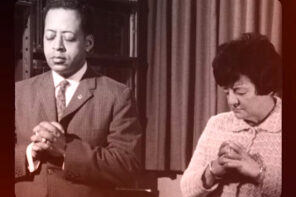In the latest addition to It’s Your Fault, The Cubit’s series on blame in contemporary society, RD associate editor Andrew Aghapour and contributor Megan Goodwin discuss public shaming and new religious movements. Goodwin’s RD article, “Don’t Be Tooken In by Kimmy Schmidt‘s Cult,” galvanized hostile reactions from across the web. For more on blame, read the introductory post or explore the full series.
This conversation was edited for clarity, length, and to insert a megaman .gif.
What was it that motivated you to write about Kimmy Schmidt in the first place?
I’m deeply invested in public conversations about religion, gender, and sexuality, and the opening sequence of the show perfectly encapsulates the dynamic I’m exploring in my current project. It depicts women dressed conservatively, engaged in unusual religious practices and talking about the end of the world, before being rescued by large white men in flak jackets.
“They’re alive, dammit! It’s a miracle!”
And it’s this dynamic that I’ve been trying to parse. Obviously, with Kimmy Schmidt, these women were being held hostage and abused. As much as I adore Tina Fey, my concern was that the show adds to a cultural narrative that only sees women in minority religions as hostages.
In your study of captivity narratives you’ve found that certain tropes repeat themselves regardless of the reality at hand?
Yes! Captivity narratives are a distinctly (though not uniquely) American genre, the popularity of which dates back to contact with indigenous North Americans. As a genre, they conflate contact with outsiders with sexual and religious peril.
They share certain conventions: the protagonists are almost always white women who are taken hostage by religious (and often racial) others who threaten their religious and sexual purity. The women persevere until they are rescued, usually by white men. There are captivity narratives that deal with American Indians, Catholics, Muslims, Mormons, and witches. I’m focusing on the last three in my current project.
Part of what I’m looking at is the recurrence of themes in the stories Americans tell ourselves about what happens when we make contact with religious outsiders, and why we assume religious difference equals sexual menace.
I imagine that there have been cases where white woman have indeed been taken hostage by religious others and rescued by white men, of course. But your contention is that this narrative exceeds the particulars it might be based on, and that it has dangerous effects?
Very much so. Yes, women have absolutely been held against their will in minority religions. And sometimes people grow up in situations within minority religions that they later realize were abusive. Nothing I’ve ever written has downplayed or denied the reality that abuse happens in minority religions.
The point I’ve been trying to make is that abuse isn’t unique to minority religions. We don’t see more abuse in minority religions than in mainstream American culture.
What I’ve been trying to highlight is that (a) abuse happens everywhere, absolutely everywhere—sexual abuse of women and children in the United States is rampant; but that, (b) the American public reacts in very different ways to abuse that happens within minority religious communities than it does to abuse happening in mainstream American households.
And by “reacts in very different ways,” I mean, “sends tanks in to stop it.” (RD has covered this before.) I’m interested in why minority religions so frequently face suspicions of sexual transgression. And why, in a society rife with under-reported and inadequately addressed sexual abuse of women and children, Americans are so eager to locate and combat abuse on the nation’s religious margins.
What I liked about your Kimmy Schmidt piece was that it made just that point. And I imagine that that reaction has two dangerous effects: lumping all NRM practitioners in with sexual abuse; and “othering” captivity and abuse so that we’re less likely to look for it in “normal” society.
The latter point, promoting greater awareness of sexual abuse across all of society, is why the online reaction to your article surprised me. I posted your article on Facebook and was immediately barraged with angry comments.
Same here. One consistent point of pushback was from former members of new religious movements. I’ve heard from former Children of God, Christian Science, and Mormon fundamentalism members, all of whom are deeply invested in confirming that abuse does happen in NRMs. These people have obviously been through traumatic and painful experiences in their background.
And their voices should be heard. But some of the responses were extremely hostile. Someone even contacted your dean?
[They were] concerned that I was, “ignoring the realities of sexism and sexual assault in minority religions.” This person contacted the dean of faculty and also referenced an article I wrote seven years ago to argue that I know nothing about my area of research.I was most surprised by the insistence—largely from women—that I just clearly didn’t care about the women who were suffering under the regimes of religiously-justified sexual tyranny that were happening—that must be happening—in new religious communities. Most of the feedback has been from women saying “but I was abused. Why don’t you acknowledge my abuse?”
And honestly, there should be more scholarly work on sexual abuse in religions—minority or otherwise. I know Katie Lofton, Kent Brintnall, Anthony Petro, and Bob Orsi are all working on Catholic clerical abuse, which is incredibly important.
But I’m trying to get at something bigger: that the efforts we’re making to try to prevent abuse in minority religious communities aren’t working. We are terrifying and alienating the communities we try to save. We need to pay attention to the root causes and contributing factors of abuse: poverty, isolation, male dominance, etc.
We have a wonky blame triangle here. You wrote an article saying, “don’t blame all NRMs for sexual violence,” and received hostile comments saying, “I blame you for not blaming arbiters of violence.” And now you’re saying, “to reduce this type of violence we actually need to blame better”?
BLAME BETTER, precisely. Or blame more broadly, more systemically. I think NRMs and minority religions make for a containable, easy target. They give us something to quite literally shoot at, all the while diverting fault from mainstream Americans.
One commenter said that you are exclaiming, “Not all NRMs!” in the same way that men respond to rape culture by claiming, “Not all men!”
This is obviously a false equivalency. “Not all men” refers to a social media campaign, mostly on twitter, exculpating “good men” from sexual violence, assault, and harassment. Obviously, yes, not all men are perpetrators of sexual abuse, but the point of that campaign was to exculpate “good men.”
Those “good men” have access to public platforms like Twitter and Facebook by which to make their case. “Men” broadly are in a position to defend themselves, and are also valued by American culture in a way that women are not. The reason it’s a false equivalency is because new religious movements and minority religions are not in a position of power or privilege.
It’s easy to tweet #notallmen and then look away when a male friend makes a sexist joke, whereas “Not all NRMs” is defending a minority group from a damaging captivity narrative.
Exactly. There is no alternative cultural narrative about minority religions. Picking on NRMs is punching down.
So when in doubt, be sure you’re punching up?
Always! (Feel free to add a megaman .gif here.)
Any final thoughts about this experience?
I think it’s valuable to have to explain and even defend your project to non-experts—it’s the easiest way to find holes in your argument. I’m slightly dismayed that the non-expert consensus is that I must not care about women or sexual abuse, when I’ve spent the last four years working on this project precisely because I’m so deeply invested in both. But again, it’s easier to blame me and minority religions than it is to blame systemic inequality. Patriarchy is a moving target.







